SDTEST® has 38 different VUCA polls that calculate the 13,643 correlation values between stages of development according to the theory of Spiral Dynamics and answer options of these 38 polls.
We invite curiosity about the systemic mechanisms behind this correlation. There may be hidden variables that provide alternative explanations.
0.1159 (Pearson) between the Sent employees on unpaid vacations and the Purple stage.
The critical value of the correlation coefficient for a normal distribution, by William Sealy Gosset (Student), is r = 0.0515. Nevertheless, this positive linear correlation of 0.1159 meets the reliability criteria but does not necessarily imply causation.
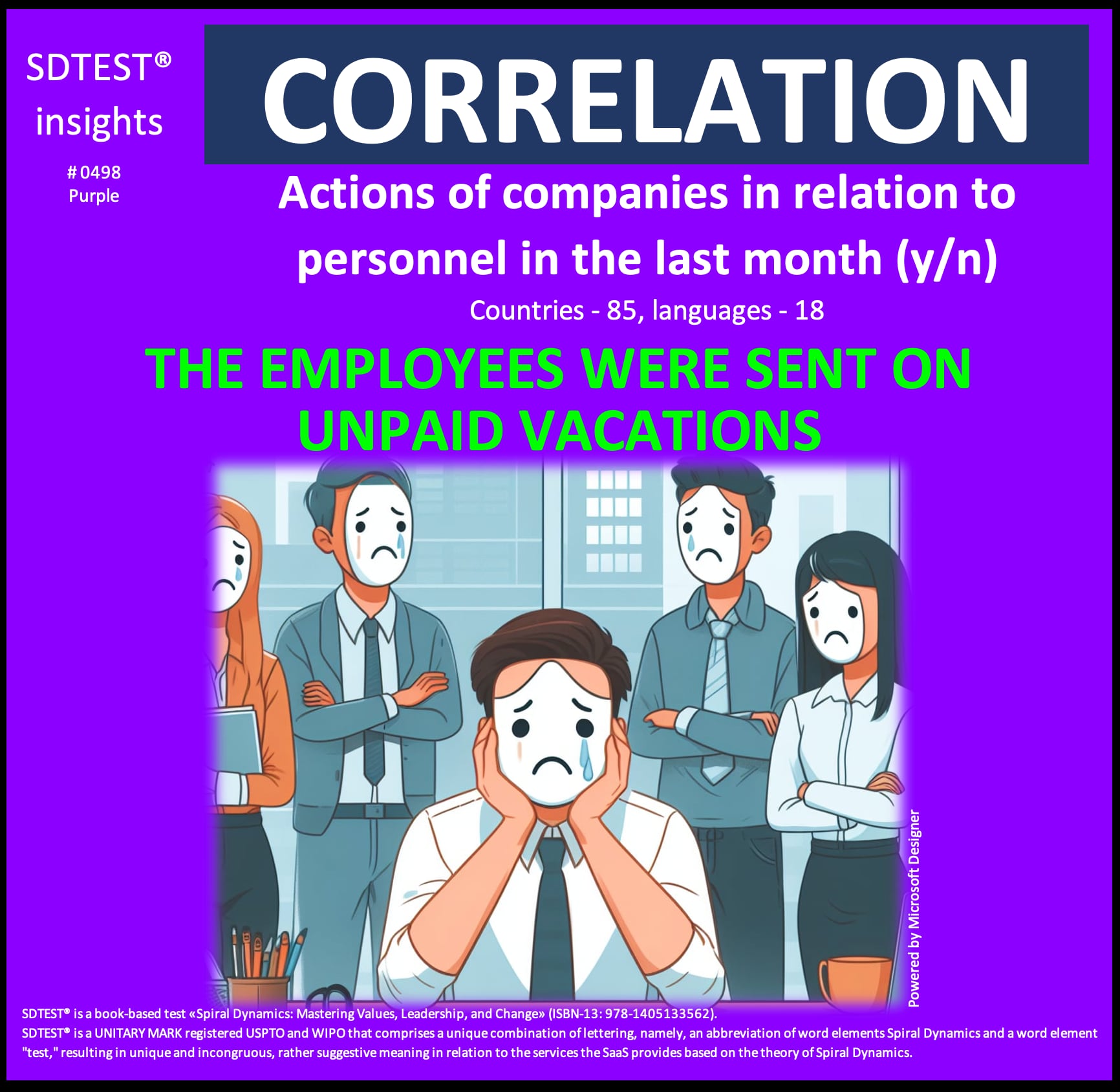
The positive correlation of 0.1159 between Sent employees on unpaid vacations and the Purple stage offers intriguing insights when viewed through the lens of the Purple value system:
Organizational Perspective:
Organizations operating within the Purple mindset might interpret this correlation as:
- Validation of their tribal approach to organizational management.
- Confirmation of their hierarchical leadership structure's absolute authority.
- Evidence supports their belief in collective sacrifice for the group's greater good.
These organizations might respond by:
- Implementing unpaid vacations as a sacred ritual of group survival.
- Reinforcing the leader's supreme decision-making power as a divine right.
- Framing unpaid vacations as a traditional method of maintaining group harmony.
Team Perspective:
Teams operating from a Purple mindset might approach this correlation by:
- Viewing unpaid vacations as a necessary tribal survival mechanism.
- Interpreting it as a test of loyalty and group commitment.
- Seeing it as a way to demonstrate collective resilience and unity.
These teams might respond by:
- Accepting unpaid vacations without questioning the leadership's wisdom.
- Creating ritualistic support systems to help members during challenging times.
- Reinforcing group bonds through shared hardship and mutual support.
Individual Perspective:
Individuals aligned with the Purple value system might interpret this correlation as:
- Personal validation of their role within the larger tribal structure.
- Evidence of their willingness to sacrifice for the group's well-being.
- Confirmation of their identity as a loyal group member.
These individuals might respond by:
- Accepting unpaid vacations as a spiritual test of their group membership.
- Seeking guidance from tribal elders and leaders during challenging times.
- Maintaining faith in the group's inherent wisdom and protective power.
This correlation, viewed through the Purple lens, suggests that those operating at the Purple level see unpaid vacations not as a hardship, but as a sacred tribal practice. It implies that the Purple value system's emphasis on group survival, hierarchical structure, and collective identity aligns with a unique approach to organizational challenges.
The reasons why employees were sent on unpaid vacations in the Purple stage could include:
- Tribal Survival: Unpaid vacations might be viewed as a collective survival strategy during challenging times.
- Leadership Authority: The tribe's leader has absolute power to make decisions affecting the group's welfare.
- Ritualistic Sacrifice: Time off without pay becomes a sacred ritual of group commitment and resilience.
- Mythical Protection: Believing that such sacrifices will protect the group from external threats.
- Ancestral Wisdom: Following traditional practices of collective hardship as passed down by ancestors.
This correlation prompts us to consider how deeply rooted cultural value systems influence organizational practices. It raises questions about the interplay between traditional belief systems and modern workplace dynamics, particularly in contexts where group identity and leadership authority are paramount.
Ultimately, this correlation highlights the profound impact of the Purple value system on organizational behavior. Unpaid vacations are transformed from a potential economic burden into a meaningful expression of tribal unity, collective identity, and sacred group survival strategy.
In our analysis of the poll "12 ways to build trust with others" (by Justin Wright [1]), we found an intriguing positive linear correlation that warrants closer examination:
0.1838 (Pearson) between the Apologize genuinely (Owning up to your errors shows integrity) / Disagree strongly and the Red stage.
The critical value of the correlation coefficient for a non-normal distribution, by Spearman, is r = 0.0074. Nevertheless, this positive linear correlation of 0.1838 meets the reliability criteria but does not necessarily imply causation.
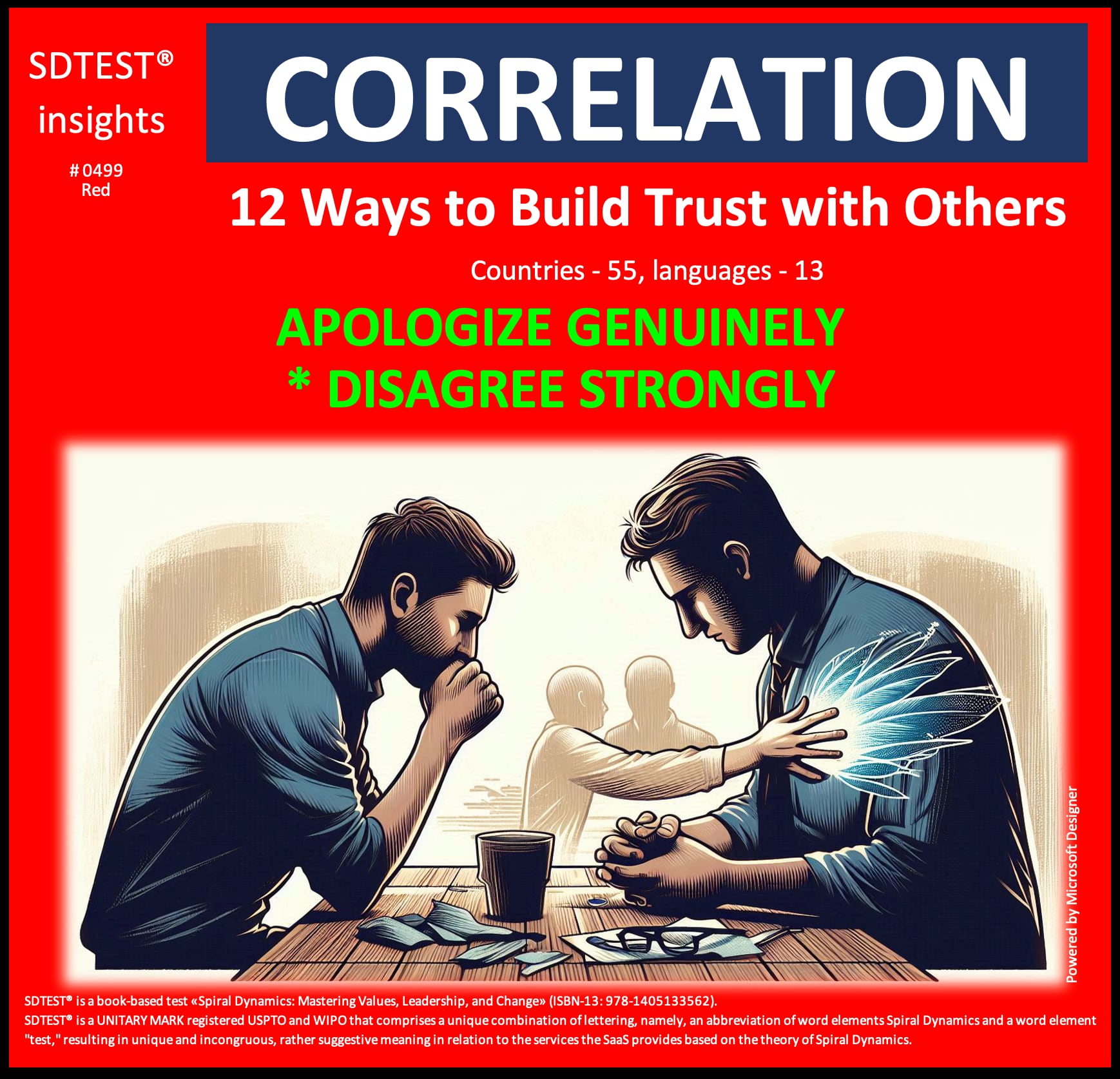
This positive correlation of 0.1838 between "Strongly Disagree with Apologizing Genuinely" and the Red stage offers intriguing insights when viewed through the lens of the Red value system:
Organizational Perspective:
Organizations operating within the Red mindset might interpret this correlation as:
- Validation of their power-driven approach, where apology is viewed as weakness and vulnerability.
- Confirmation that maintaining dominance and authority outweighs admitting errors.
- Evidence supporting their belief that strength and invulnerability build more effective power structures than integrity.
These organizations might respond by:
- Implementing systems that reward displays of strength and discourage admission of mistakes.
- Creating competitive environments where winners never acknowledge failures.
- Promoting leaders who project unwavering confidence and never back down, regardless of errors.
Team Perspective:
Teams operating from a Red mindset might approach this correlation by:
- Viewing it as an affirmation that apologizing undermines one's position in the team hierarchy.
- Interpreting it as support for their belief that power and dominance are maintained by never showing weakness.
- Seeing it as validation for prioritizing immediate respect and fear over long-term trust-building.
These teams might respond by:
- Establishing clear dominance hierarchies where the strongest members never admit fault.
- Encouraging team members to deflect blame and maintain an image of infallibility.
- Celebrating instances where team members overpower critics rather than acknowledging mistakes.
Individual Perspective:
Individuals aligned with the Red value system might interpret this correlation as:
- Personal validation of their approach to never show vulnerability through an apology.
- Evidence supporting their belief that power and respect come from projecting infallibility.
- Confirmation of the value they place on dominance over conciliation in interpersonal dynamics.
These individuals might respond by:
- Actively avoiding situations where admitting fault might be expected.
- Viewing others' apologies as opportunities to assert dominance and exploit weakness.
- Using aggressive counter-attacks when their mistakes are pointed out by others.
This correlation, viewed through the Red lens, suggests that those operating at the Red level strongly disagree with the notion that apologizing builds trust. It implies that the Red value system's emphasis on power, dominance, and personal gratification aligns with a rejection of vulnerability in relationships.
The reasons why people in the Red stage strongly disagree that apologizing genuinely builds trust could include:
- Power Preservation: Apologizing is viewed as surrendering power and admitting weakness, which undermines one's position in the dominance hierarchy.
- Status Protection: Admitting errors damages one's image of strength and invulnerability.
- Immediate Gratification: The Red stage's focus on immediate outcomes favors maintaining an appearance of strength over long-term trust building.
- Exploitation Concerns: Showing vulnerability through apology creates opportunities for others to exploit or dominate.
- Competitive Advantage: Never admitting fault is seen as maintaining an edge in competitive environments.
This correlation prompts us to consider how different value systems influence perceptions of trust-building behaviors. It raises questions about the potential drawbacks of a Red approach to interpersonal relationships, particularly in contexts where collaboration and mutual respect are crucial.
Ultimately, this correlation highlights the complex interplay between cultural values, power dynamics, and relationship development. Apologizing might be seen not as a way to build trust but as a dangerous surrender of power and position in Red-dominant environments.
In our analysis of the poll "Why do people procrastinate?" we found an intriguing negative linear correlation that warrants closer examination:
-0.0671 (Pearson) between the Overwhelm: Feeling overwhelmed by the magnitude or complexity of a task, leading to delayed action / Strongly Applicable and the Blue stage.
The critical value of the correlation coefficient for a normal distribution, by William Sealy Gosset (Student), is r = 0.0661. Nevertheless, this negative linear correlation of -0.0671 meets the reliability criteria but does not necessarily imply causation.
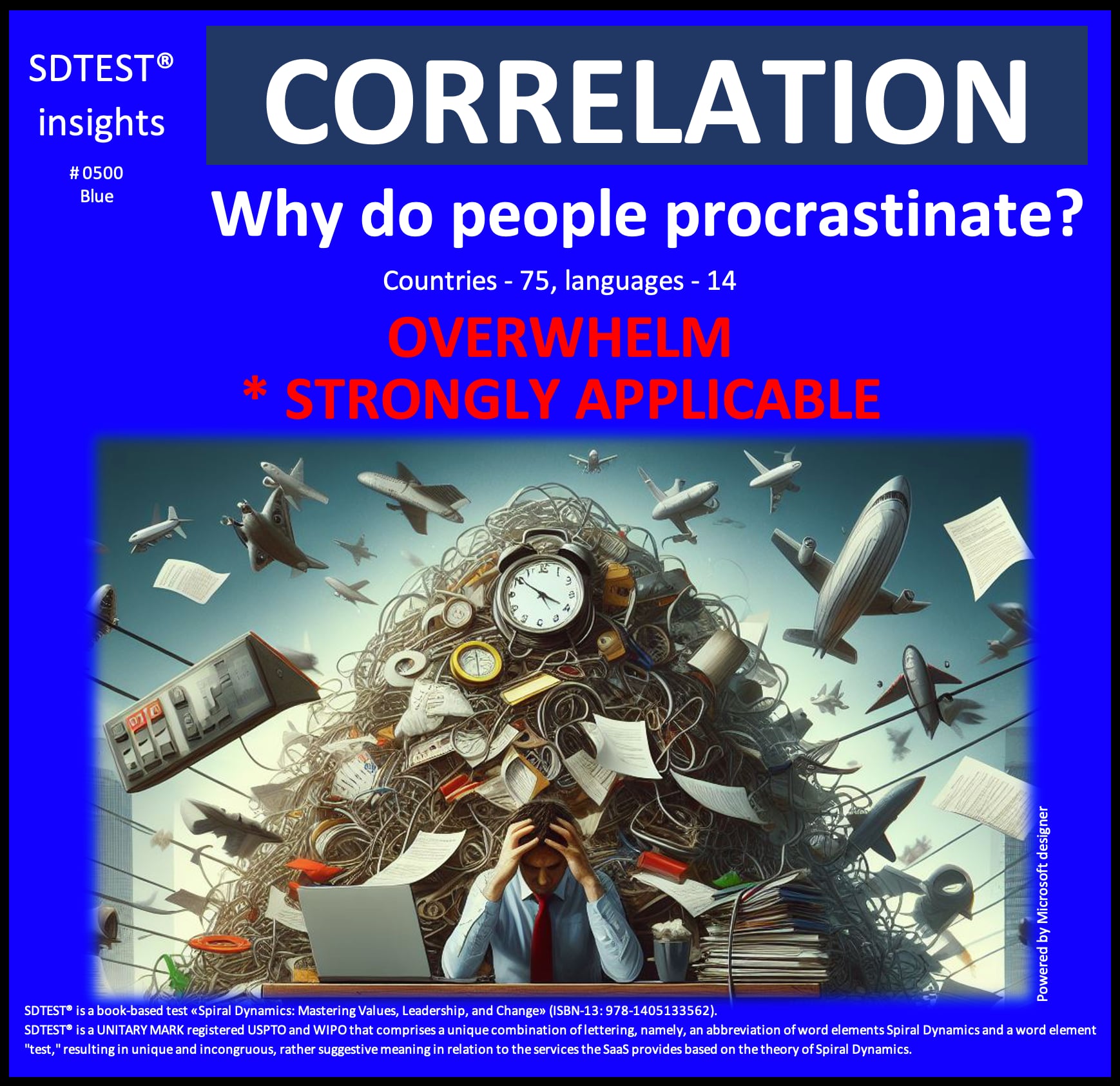
This negative correlation of -0.0671 between "Overwhelm as Strongly Applicable for Procrastination" and the Blue stage offers intriguing insights when viewed through the lens of the Blue value system:
Organizational Perspective:
Organizations operating within the Blue mindset might interpret this correlation as:
- Validation of their structured, hierarchical approach that breaks down complexity into manageable parts.
- Confirmation that their clear rules, procedures, and chain of command prevent overwhelm.
- Evidence supporting their belief that proper planning and adherence to established protocols eliminate reasons for delay.
These organizations might respond by:
- Reinforcing existing procedural frameworks that provide step-by-step guidance for all tasks.
- Implementing stricter oversight systems to ensure compliance with deadlines and standards.
- Promoting leaders who exemplify disciplined execution and unwavering commitment to duty.
Team Perspective:
Teams operating from a Blue mindset might approach this correlation by:
- Viewing it as an affirmation of their methodical, by-the-book approach to task management.
- Interpreting it as support for their belief that duty and discipline override personal feelings of overwhelm.
- Seeing it as validation for prioritizing established procedures over personal reactions to complexity.
These teams might respond by:
- Creating more detailed procedural manuals that eliminate ambiguity in task execution.
- Encouraging team members to compartmentalize tasks according to established protocols.
- Celebrating instances where team members overcome personal limitations through adherence to rules.
Individual Perspective:
Individuals aligned with the Blue value system might interpret this correlation as:
- Personal validation of their duty-bound approach to task completion regardless of complexity.
- Evidence supporting their belief that proper adherence to rules provides structure to manage any task.
- Confirmation of the value they place on discipline and moral obligation over personal feelings.
These individuals might respond by:
- Actively rejecting feelings of overwhelm as inappropriate excuses for neglecting duty.
- Viewing their capacity for self-discipline as moral strength in the face of challenging tasks.
- Using structured approaches to break down complex tasks into rule-governed components.
This correlation, viewed through the Blue lens, suggests that those operating at the Blue level are less likely to cite overwhelm as a reason for procrastination. It implies that the Blue value system's emphasis on order, discipline, and duty aligns with a rejection of personal limitations as valid reasons for delay.
The reasons why Overwhelm might not be strongly applicable as a reason for procrastination in the Blue stage could include:
- Duty Over Feelings: In the Blue stage, personal duty and moral obligation supersede subjective feelings like being overwhelmed.
- Structured Approach: The Blue stage's focus on order and structure means tasks are typically broken down into manageable steps.
- Clear Authority: The presence of clear authority and a chain of command provides guidance when tasks seem complex.
- Moral Imperative: The strong sense of right and wrong creates a moral obligation to complete tasks regardless of difficulty.
- Rule-Following: Having clear rules and procedures eliminates uncertainty that might lead to feelings of overwhelm.
This correlation prompts us to consider how different value systems influence perceptions of procrastination. It raises questions about the potential benefits of a Blue approach to task management, particularly in contexts where structure and discipline are crucial.
Ultimately, this correlation highlights the profound impact of the Blue value system on work ethic and task completion. Feelings of overwhelm may be seen not as valid reasons for delay but as moral weaknesses to be overcome through discipline, duty, and adherence to established order.
In our analysis of the poll "I live thinking about my past, present, or future," we found an intriguing positive linear correlation that warrants closer examination:
0.0871 (Pearson) between the Future and the Orange stage.
The critical value of the correlation coefficient for a normal distribution, by William Sealy Gosset (Student), is r = 0.0551. Nevertheless, this positive linear correlation of 0.0871 meets the reliability criteria but does not necessarily imply causation.

This positive correlation of 0.0871 between "Living with a Future Focus" and the Orange stage offers intriguing insights when viewed through the lens of the Orange value system:
Organizational Perspective:
Organizations operating within the Orange mindset might interpret this correlation as:
- Validation of their strategic, goal-oriented approach to business planning and market positioning.
- Confirmation that their emphasis on innovation and future trends drives competitive advantage.
- Evidence supporting their belief that a forward-thinking orientation maximizes growth and profit potential.
These organizations might respond by:
- Implementing more sophisticated forecasting and predictive analytics systems.
- Designing incentive structures that reward long-term strategic thinking and innovation.
- Promoting leaders who demonstrate exceptional vision and future-oriented strategic capabilities.
Team Perspective:
Teams operating from an Orange mindset might approach this correlation by:
- Viewing it as an affirmation of their results-driven, achievement-oriented team dynamic.
- Interpreting it as support for their belief that planning and strategic foresight outperform reactive approaches.
- Seeing it as validation for prioritizing measurable goals and future outcomes over present comfort.
These teams might respond by:
- Creating more robust project management systems with clear future milestones.
- Encouraging team members to develop strategic thinking capabilities through competitive scenario planning.
- Celebrating instances where future-focused initiatives delivered measurable results and competitive advantage.
Individual Perspective:
Individuals aligned with the Orange value system might interpret this correlation as:
- Personal validation of their achievement-oriented approach to career and life planning.
- Evidence supporting their belief that strategic thinking and goal setting lead to personal success.
- Confirmation of the value they place on continuous improvement and future advancement.
These individuals might respond by:
- Actively seeking opportunities to develop long-term career strategies and personal growth plans.
- Viewing their capacity for future-oriented thinking as a competitive advantage in the marketplace.
- Using rational analysis and trend forecasting to position themselves optimally for future success.
This correlation, viewed through the Orange lens, suggests that those operating at the Orange level have a stronger tendency to live focused on the future. It implies that the Orange value system's emphasis on achievement, progress, and strategic thinking naturally aligns with a forward-looking temporal orientation.
The reasons why people live thinking about their future in the Orange stage could include:
- Achievement Drive: In the Orange stage, success is measured by tangible achievements, requiring planning and future orientation.
- Strategic Advantage: A focus on the future provides a competitive edge through anticipation of trends and opportunities.
- Progress Imperative: The Orange stage's focus on growth and advancement necessitates future-oriented planning.
- Rational Optimization: The belief that the future can be analytically predicted and optimized through rational planning.
- Success Metrics: Future goals provide clear benchmarks to measure progress and achievement.
This correlation prompts us to consider how different value systems influence temporal orientation. It raises questions about the potential benefits and limitations of a future-focused mindset, particularly in contexts where rapid adaptation and strategic positioning are crucial.
Ultimately, this correlation highlights the profound relationship between the Orange value system and a future temporal orientation. Living with the future in mind becomes not just a temporal preference but a strategic imperative for maximizing personal and organizational success in competitive environments driven by innovation, growth, and achievement.
In our analysis of the poll "Reasons why people give up" (by Anna Vital [2]), we found an intriguing negative linear correlation that warrants closer examination:
-0.0736 (Pearson) between the Feel sorry for themselves and the Green stage.
The critical value of the correlation coefficient for a normal distribution, by William Sealy Gosset (Student), is r = 0.0535. Nevertheless, this negative linear correlation of -0.0736 meets the reliability criteria but does not necessarily imply causation.

This negative correlation of -0.0736 between "Feeling Sorry for Themselves" and the Green stage offers intriguing insights when viewed through the lens of the Green value system:
Organizational Perspective:
Organizations operating within the Green mindset might interpret this correlation as:
- Validation of their community-centered approach that emphasizes collective support and emotional processing.
- Confirmation that their focus on inclusive dialogue and shared responsibility transforms self-pity into constructive action.
- Evidence supporting their belief that communal care and ecological awareness create resilience beyond individual victimhood.
These organizations might respond by:
- Implementing more robust support systems that honor emotional experiences while preventing stagnation in self-pity.
- Designing collaborative processes that transform personal struggles into opportunities for collective growth.
- Promoting leaders who demonstrate empathetic strength and the ability to channel emotional awareness toward systemic change.
Team Perspective:
Teams operating from a Green mindset might approach this correlation by:
- Viewing it as an affirmation of their inclusive, emotionally intelligent team dynamic.
- Interpreting it as support for their belief that shared vulnerability creates strength rather than self-pity.
- Seeing it as validation for prioritizing collective well-being and mutual support over individual defeatism.
These teams might respond by:
- Creating more nuanced emotional processing spaces that distinguish between healthy vulnerability and self-pity.
- Encouraging team members to develop empathetic perspectives that contextualize personal struggles within larger systems.
- Celebrating instances where emotional challenges were transformed into collective learning and systemic improvement.
Individual Perspective:
Individuals aligned with the Green value system might interpret this correlation as:
- Personal validation of their community-oriented approach to processing difficulties.
- Evidence supporting their belief that contextualizing personal struggles within larger systems prevents self-pity.
- Confirmation of the value they place on transforming personal pain into collective action and systemic change.
These individuals might respond by:
- Actively seeking opportunities to process emotional challenges through dialogue and community connection.
- Viewing their capacity for empathy and systems thinking as resources that prevent wallowing in self-pity.
- Using ecological awareness and interconnected perspectives to move beyond personal victimhood.
This correlation, viewed through the Green lens, suggests that those operating at the Green level are less likely to give up due to feeling sorry for themselves. It implies that the Green value system's emphasis on community, ecology, and holistic thinking naturally counteracts the tendency toward self-pity and resignation.
The reasons why feeling sorry for oneself might not be a significant reason for giving up in the Green stage could include:
- Communal Support: In the Green stage, robust community networks provide emotional validation that prevents isolation and self-pity.
- Systemic Perspective: A holistic understanding of challenges as part of larger systems reduces personalization and victimhood.
- Shared Responsibility: The Green stage's focus on collective action distributes the emotional burden of setbacks.
- Transformative Dialogue: Open communication transforms personal struggles into shared learning experiences.
- Ecological Awareness: Understanding one's place in the larger web of life provides a perspective that counteracts self-centered defeatism.
This correlation prompts us to consider how different value systems influence resilience and perseverance. It raises questions about the potential benefits of a Green approach to challenges, particularly in contexts where complexity, interconnection, and systemic thinking are crucial.
Ultimately, this correlation highlights the powerful relationship between the Green value system and emotional resilience. The Green perspective's emphasis on community, ecology, and holistic thinking creates a context where feeling sorry for oneself becomes less relevant as a reason for giving up, replaced instead by a deeper awareness of interconnection and collective possibility.
In our analysis of the poll "XING's culture assessment" (Leadership. Imagine the perfect people manager. What do you expect from them?), we found an intriguing positive linear correlation that warrants closer examination:
0.2456 (Pearson) between the They let me evaluate things critically and the Yellow stage.
The critical value of the correlation coefficient for a normal distribution, by William Sealy Gosset (Student), is r = 0.1492. Nevertheless, this positive linear correlation of 0.2456 meets the reliability criteria but does not necessarily imply causation.
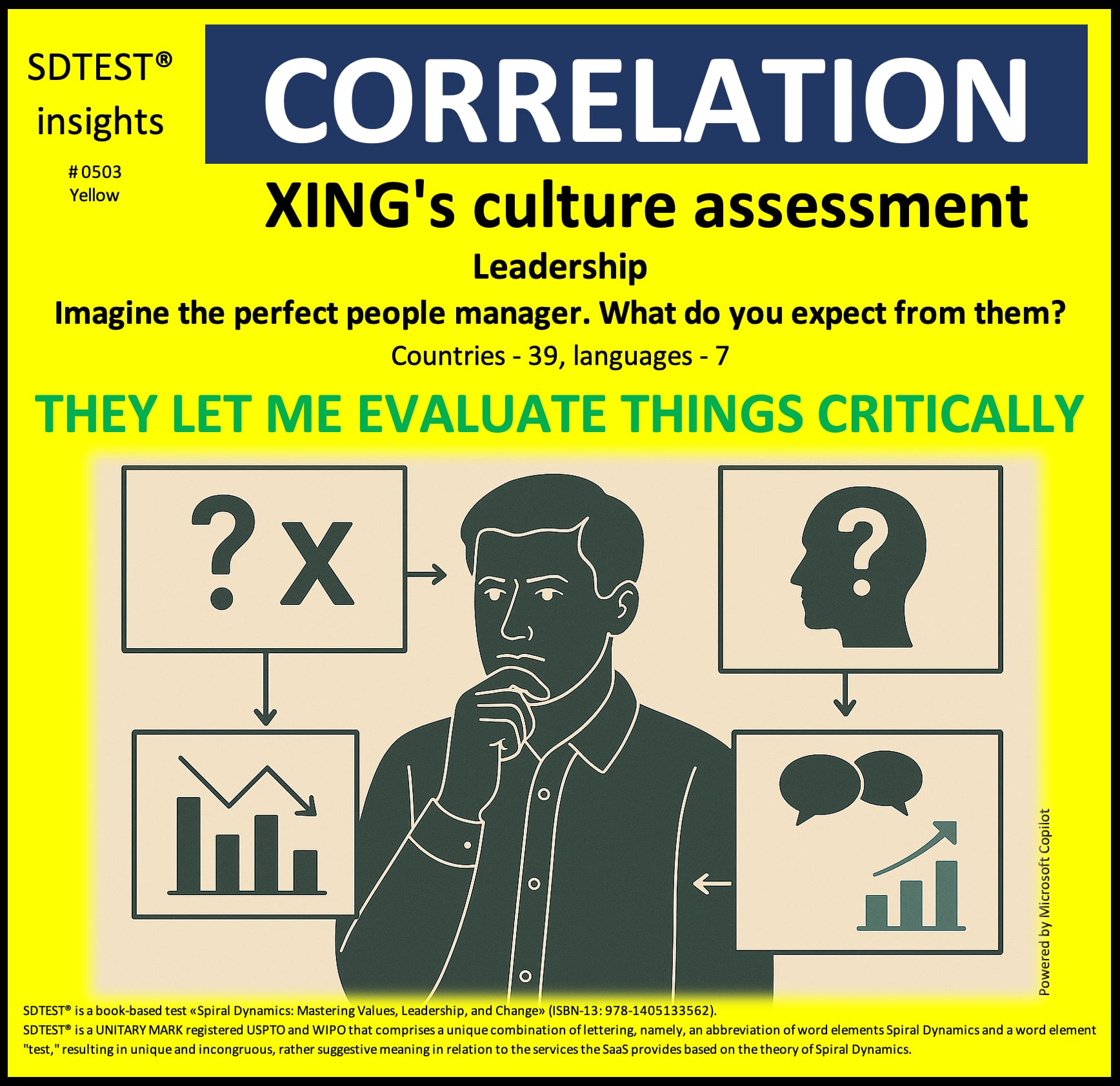
This positive correlation of 0.2456 between "Expecting to Evaluate Things Critically" and the Yellow stage offers intriguing insights when viewed through the lens of the Yellow value system:
Organizational Perspective:
Organizations operating within the Yellow mindset might interpret this correlation as:
- Validation of their flexible, systems-based approach that encourages multi-perspective critical evaluation at all levels.
- Confirmation that their emphasis on integrative thinking and functional structures catalyzes innovation and adaptive capacity.
- Evidence supports their belief that autonomous individuals' critical evaluation creates more resilient and responsive systems.
These organizations might respond by:
- Implementing more sophisticated feedback loops that invite critical evaluation across hierarchical boundaries.
- Designing organizational structures that adapt dynamically based on critical insights from throughout the system.
- Promoting leaders who demonstrate meta-cognitive abilities and can facilitate critical thinking across diverse value systems.
Team Perspective:
Teams operating from a Yellow mindset might approach this correlation by:
- Viewing it as an affirmation of their fluid, competence-based team dynamics that value critical evaluation.
- Interpreting it as support for their practice of holding multiple perspectives simultaneously during evaluation processes.
- Seeing it as validation for prioritizing systemic understanding over rigid methodologies or groupthink.
These teams might respond by:
- Creating more nuanced evaluation frameworks that integrate multiple value systems and perspectives.
- Encouraging team members to develop meta-cognitive skills and perspective-taking capabilities.
- Celebrating instances where critical evaluation led to breakthrough insights and systemic evolution.
Individual Perspective:
Individuals aligned with the Yellow value system might interpret this correlation as:
- Personal validation of their integrative, multi-perspective approach to critical evaluation.
- Evidence supporting their intuitive understanding that effective evaluation requires transcending single value systems.
- Confirmation of the value they place on autonomous thinking within complex adaptive systems.
These individuals might respond by:
- Actively seeking opportunities to develop even more sophisticated evaluative frameworks.
- Viewing their capacity for systems thinking and meta-cognition as essential for effective critical evaluation.
- Using their understanding of developmental stages to evaluate contextually across different domains.
This correlation, viewed through the Yellow lens, suggests that those operating at the Yellow level have a stronger expectation for being able to evaluate things critically. It implies that the Yellow value system's emphasis on systems thinking, integration of multiple perspectives, and functional competence naturally aligns with sophisticated critical evaluation capabilities.
The reasons why people expect that they can evaluate things critically in the Yellow stage could include:
- Meta-Cognitive Capacity: In the Yellow stage, individuals have developed the ability to observe their own thinking and recognize the limitations of single perspectives.
- Systems Integration: A comprehensive understanding of the strengths and weaknesses of previous value systems enables more nuanced evaluation.
- Complexity Navigation: The Yellow stage's comfort with complexity and paradox allows for critical evaluation that honors nuance rather than seeking simplistic answers.
- Autonomous Competence: The emphasis on functional capability empowers individuals to trust their evaluative judgment beyond external validation.
- Developmental Awareness: Understanding developmental stages provides context for evaluating ideas, people, and systems according to their appropriate contexts.
This correlation prompts us to consider how different value systems influence expectations around critical evaluation. It raises questions about the potential benefits of a Yellow approach to leadership and organizational design, particularly in contexts where complexity, adaptation, and systemic thinking are crucial.
Ultimately, this correlation highlights the profound relationship between the Yellow value system and sophisticated critical evaluation. The expectation to evaluate critically becomes not just a preference but an essential expression of an integrative consciousness capable of navigating complexity and transcending the limitations of single-perspective thinking.
In our analysis of the poll "Characteristics of a talented employee" (by TMI [3]), we found an intriguing negative linear correlation that warrants closer examination:
-0.2112 (Pearson) between the Decision-making skills and the Turquoise stage.
The critical value of the correlation coefficient for a normal distribution, by William Sealy Gosset (Student), is r = 0.1296. Nevertheless, this negative linear correlation of -0.2112 meets the reliability criteria but does not necessarily imply causation.
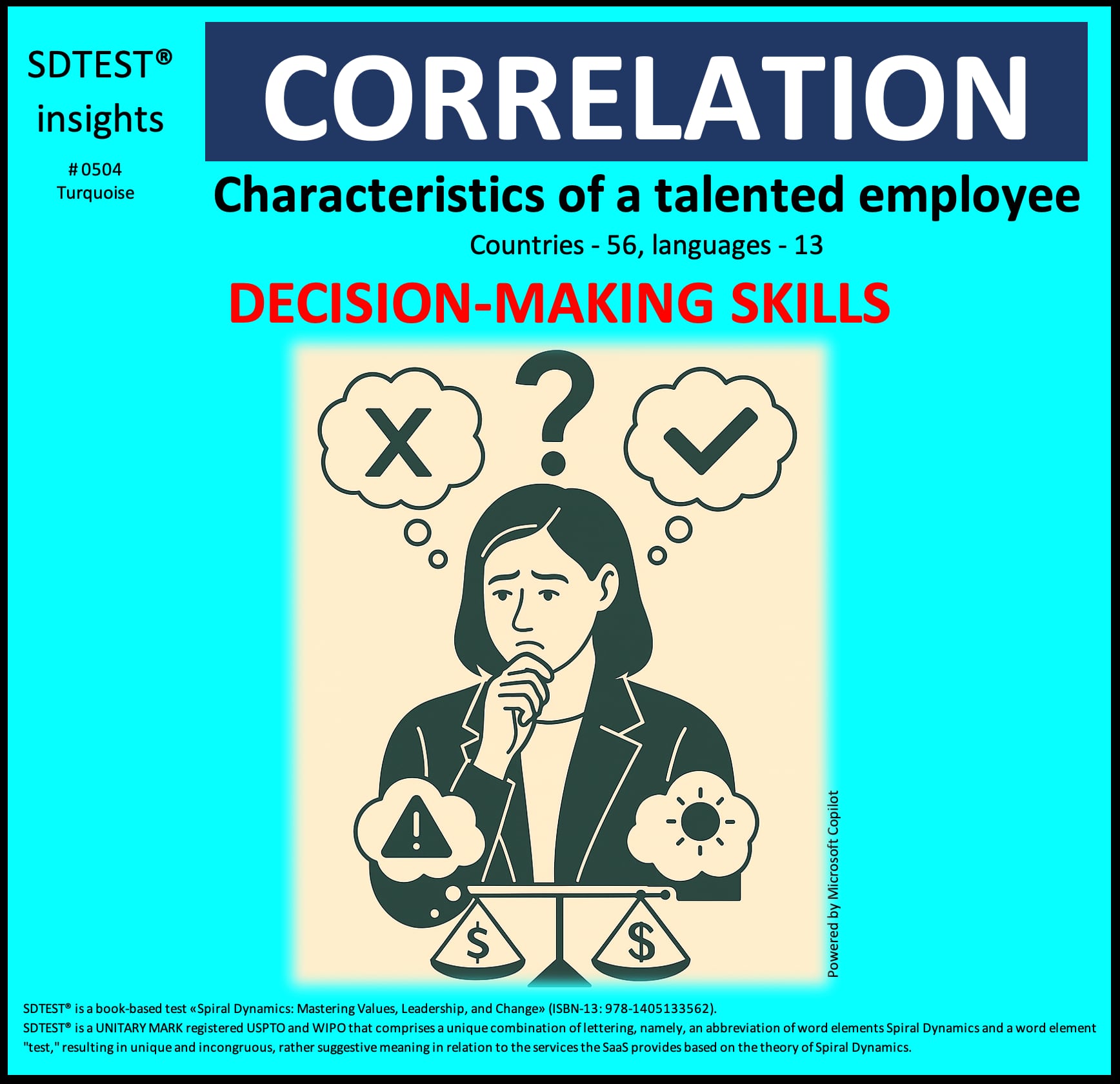
This negative correlation of -0.2112 between "Decision-making skills" and the Turquoise stage offers intriguing insights when viewed through the lens of the Turquoise value system:
Organizational Perspective:
Organizations operating within the Turquoise mindset might interpret this correlation as:
- Validation of their holistic approach that transcends conventional decision-making in favor of emergent wisdom.
- Confirmation that their focus on living systems and collective intelligence surpasses individual decision-making skills.
- Evidence supporting their belief that interconnected awareness and fluid responsiveness matter more than discrete decisional moments.
These organizations might respond by:
- Implementing more integrative processes that allow solutions to emerge from collective field awareness rather than individual decisions.
- Designing organizational structures that function as living systems with distributed intelligence rather than hierarchical decision points.
- Promoting leaders who demonstrate capacity for sensing emergent patterns and facilitating collective wisdom rather than decisive action.
Team Perspective:
Teams operating from a Turquoise mindset might approach this correlation by:
- Viewing it as an affirmation of their integrated, field-aware team consciousness that transcends individual decision-making.
- Interpreting it as support for their practice of holding space for emergence rather than forcing decisive outcomes.
- Seeing it as validation for prioritizing holistic awareness and collective intelligence over individual decisional authority.
These teams might respond by:
- Creating more contemplative spaces that allow for sensing the whole system before responsive action.
- Encouraging team members to develop deeper ecological awareness and systemic sensitivity.
- Celebrating instances where patient attention to the whole yielded more harmonious outcomes than decisive intervention.
Individual Perspective:
Individuals aligned with the Turquoise value system might interpret this correlation as:
- Personal validation of their intuitive knowing that transcends conventional decision-making processes.
- Evidence supporting their sense that being attuned to living systems matters more than making discrete choices.
- Confirmation of the value they place on holistic awareness and field sensitivity over decisional agency.
These individuals might respond by:
- Actively seeking to deepen their capacity for sensing emergent patterns in complex systems.
- Viewing their ecological awareness and interconnected consciousness as more valuable than decisional clarity.
- Using contemplative practices to access collective wisdom beyond individual decision-making.
This correlation, viewed through the Turquoise lens, suggests that those operating at the Turquoise level place less emphasis on conventional decision-making skills as a talent marker. It implies that the Turquoise value system's emphasis on holistic integration, living systems awareness, and ecological consciousness reframes what constitutes a valuable contribution beyond decisional capability.
The reasons why decision-making skills might not be characteristic of a talented employee in the Turquoise stage could include:
- Systems Awareness: In the Turquoise stage, sensing the whole system and its emergent properties supersedes making discrete decisions.
- Collective Intelligence: A recognition that wisdom emerges from the field of collective awareness rather than individual choice points.
- Ecological Harmony: The Turquoise stage's focus on living in harmony with natural systems requires attunement more than intervention.
- Integrative Consciousness: The ability to hold paradox and complexity without reducing to binary decisions becomes more valuable.
- Emergent Flow: Understanding that the most appropriate actions often arise organically from systemic awareness rather than deliberate choice.
This correlation prompts us to consider how evolved value systems reframe our understanding of talent and contribution. It raises questions about the potential limitations of conventional decision-making in contexts requiring holistic awareness, emergent wisdom, and living systems intelligence.
Ultimately, this correlation highlights the profound shift from mechanistic to living systems thinking. Decision-making skills become less relevant when one operates from a consciousness that senses the interconnected whole and allows appropriate action to emerge from collective intelligence and ecological wisdom.
What insights do you gain from today's correlation? How might we study this relationship more carefully before deducing causation?
We welcome respectful and wise perspectives! Stay tuned every week as we share more results and insights.
After login or registration, free access to the poll results in the FAQ section.
[1] www.linkedin.com/in/jwmba/
[2] www.linkedin.com/in/annavital/
[3] www.linkedin.com/company/talent-management-institute/
2025.05.18
FearpersonqualitiesprojectorganizationalstructureRACIresponsibilitymatrixCritical ChainProject Managementfocus factorJiraempathyleadersbossGermanyChinaPolicyUkraineRussiawarvolatilityuncertaintycomplexityambiguityVUCArelocatejobproblemcountryreasongive upobjectivekeyresultmathematicalpsychologyMBTIHR metricsstandardDEIcorrelationriskscoringmodelGame TheoryPrisoner's Dilemma
Valerii Kosenko
產品負責人 SaaS SDTEST®
Valerii 於 1993 年獲得社會教育心理學家資格,此後將他的知識應用於專案管理。
Valerii 於 2013 年獲得碩士學位以及專案和專案經理資格。
Valerii 是探討 V.U.C.A. 不確定性的作者。使用螺旋動力學和心理學數理統計的概念,以及 38 個國際民意調查。








